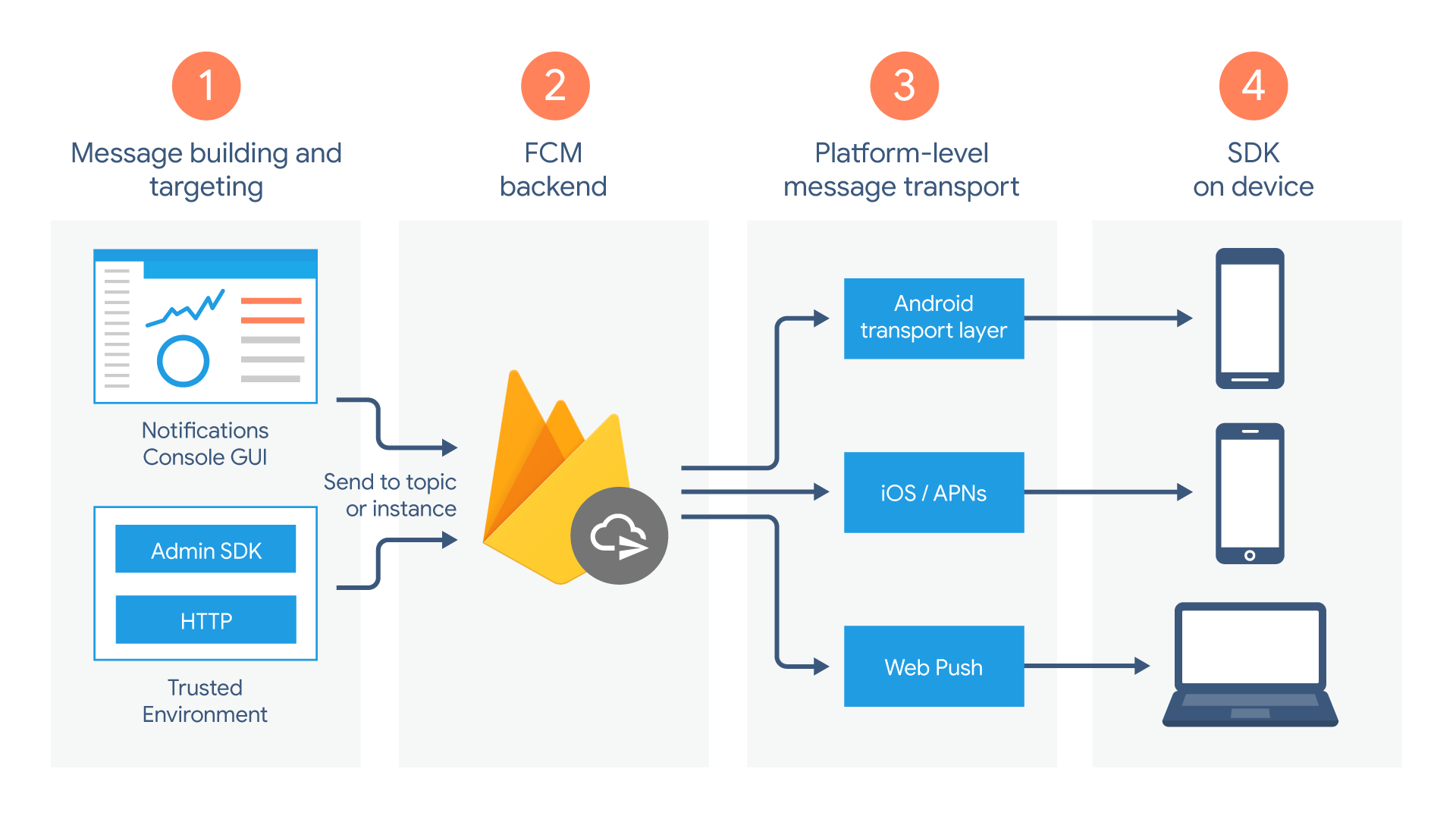FCM به مجموعه اجزای زیر که پیامها را میسازند، منتقل میکنند و دریافت میکنند، متکی است:
ابزاری برای نوشتن یا ساخت درخواستهای پیام. آهنگساز Notifications یک گزینه مبتنی بر رابط کاربری گرافیکی برای ایجاد درخواستهای اعلان ارائه میدهد. برای اتوماسیون کامل و پشتیبانی از همه انواع پیام ، باید درخواستهای پیام را در یک محیط سرور قابل اعتماد که از Firebase Admin SDK یا پروتکل سرور FCM پشتیبانی میکند، بسازید. این محیط میتواند Cloud Functions برای Firebase، App Engine یا سرور برنامه خودتان باشد.

بخش مدیریت فایل (FCM) که (در کنار سایر وظایف) درخواستهای پیام را میپذیرد، از طریق تاپیکها، فانوت پیامها را انجام میدهد و فرادادههای پیام مانند شناسه پیام را تولید میکند.
یک لایه انتقال در سطح پلتفرم، که پیام را به دستگاه مورد نظر هدایت میکند، تحویل پیام را مدیریت میکند و در صورت لزوم پیکربندی خاص پلتفرم را اعمال میکند. این لایه انتقال شامل موارد زیر است:
- لایه انتقال اندروید (ATL) برای دستگاههای اندروید با سرویسهای گوگل پلی
- سرویس اعلانهای فوری اپل (APN) برای دستگاههای اپل
پروتکل وب پوش برای برنامههای وب
کیت توسعه نرمافزار FCM روی دستگاه کاربر، جایی که اعلان نمایش داده میشود یا پیام مطابق با وضعیت پیشزمینه/پسزمینه برنامه و هرگونه منطق برنامه مربوطه مدیریت میشود.
جریان چرخه عمر
- دستگاهها را برای دریافت پیام از FCM ثبت کنید . یک نمونه از برنامه کلاینت برای دریافت پیامها ثبت میشود و یک توکن ثبت نام دریافت میکند که به طور منحصر به فرد نمونه برنامه را مشخص میکند.
- پیامهای پاییندستی را ارسال و دریافت کنید .
- ارسال پیام. سرور برنامه پیامهایی را به برنامه کلاینت ارسال میکند:
- پیام، یا در آهنگساز اعلانها یا در یک محیط قابل اعتماد، نوشته میشود و درخواست پیام به بکاند FCM ارسال میشود.
- بکاند FCM درخواست پیام را دریافت میکند، یک شناسه پیام و سایر فرادادهها را تولید میکند و آن را به لایه انتقال مخصوص پلتفرم ارسال میکند.
- وقتی دستگاه آنلاین است، پیام از طریق لایه انتقال مخصوص پلتفرم به دستگاه ارسال میشود.
- در دستگاه، برنامه کلاینت پیام یا اعلان را دریافت میکند.
- ارسال پیام. سرور برنامه پیامهایی را به برنامه کلاینت ارسال میکند:

